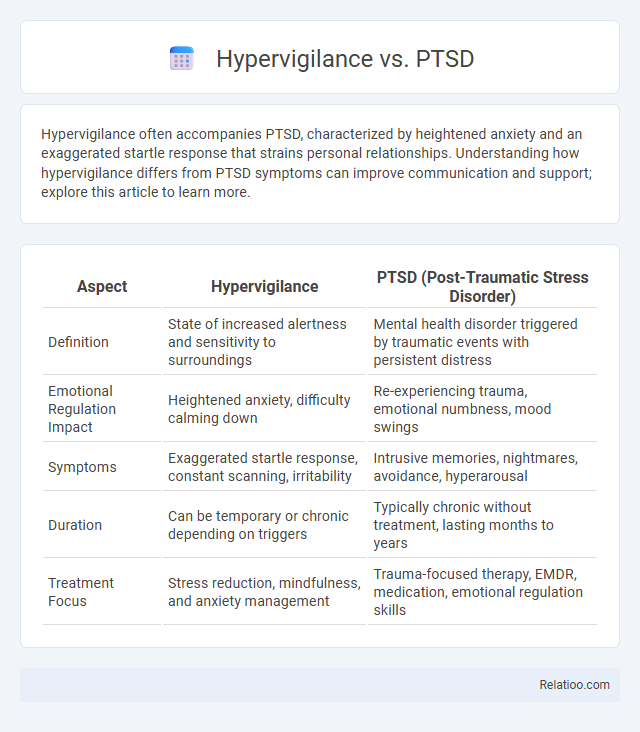Hypervigilance often accompanies PTSD, characterized by heightened anxiety and an exaggerated startle response that strains personal relationships. Understanding how hypervigilance differs from PTSD symptoms can improve communication and support; explore this article to learn more.
Table of Comparison
| Aspect | Hypervigilance | PTSD (Post-Traumatic Stress Disorder) |
|---|---|---|
| Definition | State of increased alertness and sensitivity to surroundings | Mental health disorder triggered by traumatic events with persistent distress |
| Emotional Regulation Impact | Heightened anxiety, difficulty calming down | Re-experiencing trauma, emotional numbness, mood swings |
| Symptoms | Exaggerated startle response, constant scanning, irritability | Intrusive memories, nightmares, avoidance, hyperarousal |
| Duration | Can be temporary or chronic depending on triggers | Typically chronic without treatment, lasting months to years |
| Treatment Focus | Stress reduction, mindfulness, and anxiety management | Trauma-focused therapy, EMDR, medication, emotional regulation skills |
Understanding Hypervigilance: Definition and Symptoms
Hypervigilance is a state of heightened sensory sensitivity accompanied by an exaggerated intensity of behaviors aimed at detecting threats, often linked to trauma exposure. Symptoms include increased agitation, irritability, difficulty concentrating, and an exaggerated startle response, which can significantly impair daily functioning. Differentiating hypervigilance from PTSD involves recognizing that hypervigilance is a symptom commonly present within the broader diagnostic criteria of PTSD, where it manifests alongside intrusive memories, avoidance behaviors, and mood disturbances.
What Is PTSD? Core Features and Causes
PTSD, or Post-Traumatic Stress Disorder, is a mental health condition triggered by experiencing or witnessing a traumatic event, characterized by intrusive memories, avoidance behaviors, negative mood changes, and heightened arousal such as hypervigilance. Core features include re-experiencing trauma through flashbacks or nightmares, emotional numbness, and difficulties with concentration or sleep. Causes of PTSD involve exposure to life-threatening situations, serious injury, or sexual violence, with your brain remaining in a state of heightened alertness to detect potential threats.
Key Differences Between Hypervigilance and PTSD
Hypervigilance is a symptom characterized by an enhanced state of sensory sensitivity and an exaggerated intensity of behaviors aimed at detecting threats, commonly seen in PTSD but not a standalone diagnosis. PTSD, or Post-Traumatic Stress Disorder, is a complex psychiatric condition diagnosed after exposure to trauma, encompassing symptoms like intrusive memories, avoidance, negative mood, and hypervigilance. Understanding these differences helps you recognize that hypervigilance is a reactive symptom related to heightened alertness, whereas PTSD is a broader disorder requiring comprehensive clinical assessment and treatment.
Hypervigilance as a Symptom of PTSD
Hypervigilance is a core symptom of Post-Traumatic Stress Disorder (PTSD), characterized by an enhanced state of sensory sensitivity and an exaggerated intensity of behaviors aimed at detecting threats. Unlike general hypervigilance, which can occur in various anxiety disorders or as a standalone condition, hypervigilance in PTSD is directly linked to trauma and often involves persistent and intrusive trauma-related cues. This heightened state of alertness leads to continual scanning of the environment, difficulty concentrating, and sleep disturbances, significantly impairing daily functioning.
Triggers: Hypervigilance vs PTSD Experiences
Hypervigilance often manifests as an intense state of sensory sensitivity and heightened alertness to potential threats, triggered by stimuli reminiscent of past trauma or perceived danger. PTSD experiences include hypervigilance but also encompass flashbacks, nightmares, and emotional numbness, frequently triggered by specific trauma-related cues such as loud noises or situations resembling the original traumatic event. Understanding the subtle differences in triggers between hypervigilance as a standalone symptom and within PTSD is crucial for accurate diagnosis and effective therapeutic interventions.
Mental and Physical Effects of Hypervigilance
Hypervigilance, a state of heightened sensory sensitivity and extreme alertness, often accompanies PTSD but can also occur independently, intensifying mental strain and physical symptoms such as chronic fatigue, muscle tension, and increased heart rate. In PTSD, hypervigilance exacerbates anxiety, intrusive thoughts, and sleep disturbances, complicating recovery by continuously triggering the body's fight-or-flight response. Your mental health can suffer from constant overstimulation, while prolonged physical effects may lead to systemic issues like hypertension or weakened immune function, emphasizing the need for targeted interventions.
PTSD: Long-Term Impact on Mental Health
Hypervigilance, often present in PTSD, is characterized by an extreme state of sensory sensitivity and heightened alertness to potential threats, which can severely disrupt your daily functioning and quality of life. PTSD (Post-Traumatic Stress Disorder) results from exposure to traumatic events, leading to persistent mental health challenges such as anxiety, flashbacks, and emotional numbness that may last for years if untreated. The long-term impact of PTSD includes chronic stress responses, impaired cognitive function, and increased risk of other psychiatric disorders, highlighting the importance of early intervention and tailored therapeutic support for effective management.
Diagnosis: Distinguishing Hypervigilance from PTSD
Diagnosis centers on recognizing that hypervigilance is a symptom commonly found within PTSD but can also occur independently in other anxiety disorders. Accurate assessment involves evaluating the presence of additional PTSD criteria, such as intrusive memories and avoidance behaviors, to distinguish it from isolated hypervigilance. Your mental health professional uses clinical interviews and standardized tools to differentiate these conditions and guide effective treatment.
Treatment Approaches for Hypervigilance and PTSD
Treatment approaches for hypervigilance often include cognitive-behavioral therapy (CBT) and mindfulness-based stress reduction to reduce anxiety and improve emotional regulation. Post-traumatic stress disorder (PTSD) treatments incorporate trauma-focused therapies such as prolonged exposure therapy and eye movement desensitization and reprocessing (EMDR) to address traumatic memories and associated symptoms. Pharmacological interventions, including selective serotonin reuptake inhibitors (SSRIs), may be utilized for both hypervigilance and PTSD to alleviate symptoms of anxiety and depression.
Coping Strategies and Support Resources
Effective coping strategies for hypervigilance and PTSD include grounding techniques, mindfulness meditation, and cognitive-behavioral therapy (CBT), which help regulate anxiety and reduce hyperarousal symptoms. Support resources such as trauma-focused support groups, mental health professionals specializing in PTSD, and online communities offer essential emotional support and education. Combining professional therapy with peer support enhances resilience and promotes long-term recovery from hypervigilance-related trauma.

Infographic: Hypervigilance vs PTSD
 relatioo.com
relatioo.com